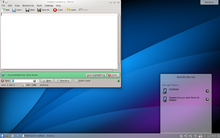Microsoft Windows[edit]
Main article: Microsoft Windows
Microsoft Windows is the collective brand name of several operating systems made by Microsoft which, as of 2015, are installed on PCs built by HP, Dell andLenovo, the three remaining high volume manufacturers.[68] Microsoft first introduced an operating environment named Windows in November 1985,[69] as an add-on to MS-DOS and in response to the growing interest in graphical user interfaces (GUIs)[70][71] generated by Apple's 1984 introduction of the Macintosh.[72] As of August 2015, the most recent client and server version of Windows are Windows 10 and Windows Server 2012 R2, respectively.
OS X[edit]
Main article: OS X
OS X (formerly Mac OS X) is a line of operating systems developed, marketed and sold by Apple Inc.. OS X is the successor to the original Mac OS, which had been Apple's primary operating system since 1984. OS X is a Unix-based graphical operating system, and Snow Leopard, Leopard, Lion, Mountain Lion, Mavericks andYosemite are its version codenames. The most recent version of OS X is codenamed El Capitan.
On iPhone, iPad and iPod, versions of iOS (which is an OS X derivative) are available from iOS 1.0 to the recent iOS 9. The iOS devices, however, are not considered PCs.
Linux[edit]
Main article: Linux
Linux is a family of Unix-like computer operating systems. Linux is one of the most prominent examples of free software andopen source development: typically all underlying source code can be freely modified, used, and redistributed by anyone.[73]The name "Linux" refers to the Linux kernel, started in 1991 by Linus Torvalds. The system's utilities and libraries usually come from the GNU operating system, announced in 1983 by Richard Stallman. The GNU contribution is the basis for thealternative name GNU/Linux.[74]
Known for its use in servers, with the LAMP application stack as one of prominent examples, Linux is supported by corporations such as Dell, Hewlett-Packard, IBM, Novell, Oracle Corporation, Red Hat, Canonical Ltd. and Sun Microsystems. It is used as an operating system for a wide variety of computer hardware, including desktop computers,netbooks, supercomputers,[75] video game systems such as the Steam Machine or PlayStation 3 (until this option was removed remotely by Sony in 2010[76]), several arcade games, and embedded devices such as mobile phones, portable media players, routers, and stage lighting systems.
Applications[edit]
| This section does not cite any references (sources). (April 2014) |
Main article: Application software
Generally, a computer user uses application software to carry out a specific task. System software supports applications and provides common services such as memory management, network connectivity and device drivers, all of which may be used by applications but are not directly of interest to the end user. A simplified analogy in the world of hardware would be the relationship of an electric light bulb (an application) to an electric power generation plant (a system): the power plant merely generates electricity, not itself of any real use until harnessed to an application like the electric light that performs a service that benefits the user.
Typical examples of software applications are word processors, spreadsheets, and media players. Multiple applications bundled together as a package are sometimes referred to as an application suite. Microsoft Office and OpenOffice.org, which bundle together a word processor, a spreadsheet, and several other discrete applications, are typical examples. The separate applications in a suite usually have a user interface that has some commonality making it easier for the user to learn and use each application. Often, they may have some capability to interact with each other in ways beneficial to the user; for example, a spreadsheet might be able to be embedded in a word processor document even though it had been created in the separate spreadsheet application.
End-user development tailors systems to meet the user's specific needs. User-written software include spreadsheet templates, word processor macros, scientific simulations, graphics and animation scripts; even email filters are a kind of user software. Users create this software themselves and often overlook how important it is.
Gaming[edit]
PC gaming is popular among the high-end PC market. According to an April 2014 market analysis, Gaming platforms like Steam (software), Uplay, Origin, andGOG.com (as well as competitive e-sports titles like League of Legends) are largely responsible for PC systems overtaking console revenue in 2013.[77]
Toxicity[edit]
Toxic chemicals found in some computer hardware include lead, mercury, cadmium, chromium, plastic (PVC), and barium. Overall, a computer is about 17% lead,copper, zinc, mercury, and cadmium; 23% is plastic, 14% is aluminum, and 20% is iron.
Lead is found in a cathode ray tube (CRT) display, and on all of the printed circuit boards and most expansion cards. Mercury is located in the screen's fluorescent lamp, in the laser light generators in the optical disk drive, and in the round, silver-looking batteries on the motherboard. Plastic is found mostly in the housing of the computation and display circuitry.
While daily end-users are not exposed to these toxic elements, the danger arises during the computer recycling process, which involves manually breaking down hardware and leads to the exposure of a measurable amount of lead or mercury. A measurable amount of lead or mercury can easily cause serious brain damage or ruin drinking water supplies. Computer recycling is best handled by the electronic waste (e-waste) industry, and kept segregated from the general communitydump.


